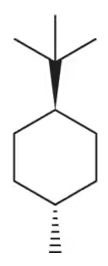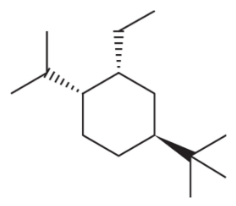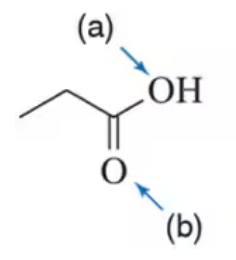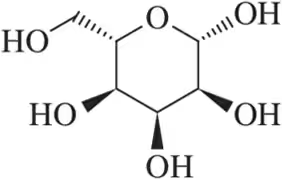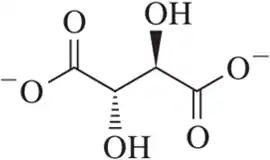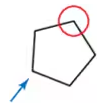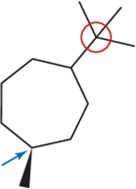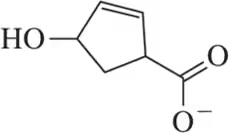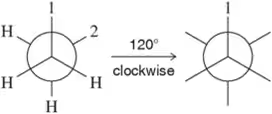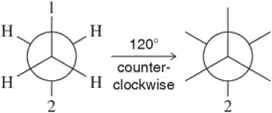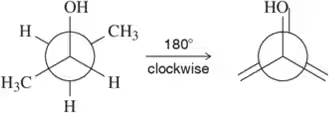 Back
Back Mullins 1st Edition
Mullins 1st Edition Ch. 3 - Alkanes and Cycloalkanes: Properties and Conformational Analysis
Ch. 3 - Alkanes and Cycloalkanes: Properties and Conformational AnalysisProblem 41c
Draw two different chair conformations for each of the following molecules. Make sure that your drawings clearly show the cis–trans stereochemistry.
(c)
Problem 42
For each pair of conformations you drew in Assessment 3.41, indicate which is most stable.
Problem 43
Draw the most stable chair conformation for the following trisubstituted cyclohexane.
Problem 44a
Based on the formal charge, determine how many lone pairs are on each indicated atom.
(a)
Problem 45a
Modify the following line-angle drawings to show all lone pairs.
(a)
Problem 45b
Modify the following line-angle drawings to show all lone pairs.
(b)
Problem 46c
Given the line-angle drawings shown, answer the following questions:
(i) How many carbons are in each molecule?
(ii) How many hydrogens are at the circled carbon?
(iii) Is the indicated (→) carbon or 1° , 2°, 3°, or 4°?
(c)
Problem 46e
Given the line-angle drawings shown, answer the following questions:
(i) How many carbons are in each molecule?
(ii) How many hydrogens are at the circled carbon?
(iii) Is the indicated (→) carbon or 1° , 2°, 3°, or 4°?
(e)
Problem 46f
Given the line-angle drawings shown, answer the following questions:
(i) How many carbons are in each molecule?
(ii) How many hydrogens are at the circled carbon?
(iii) Is the indicated (→) carbon or 1° , 2°, 3°, or 4°?
(f)
Problem 46h
Given the line-angle drawings shown, answer the following questions:
(i) How many carbons are in each molecule?
(ii) How many hydrogens are at the circled carbon?
(iii) Is the indicated (→) carbon or 1° , 2°, 3°, or 4°?
(h)
Problem 47c
Represent each of the following condensed structural formulas using a line-angle drawing.
(c) CH3CHOHCH2CHBrCH3
Problem 47d
Represent each of the following condensed structural formulas using a line-angle drawing.
(d) CH3CH2CH2CCH2OH
Problem 47e
Represent each of the following condensed structural formulas using a line-angle drawing.
(e) (CH3)2CHCH2CH2CH2CH2CHO
Problem 48b
For each molecular formula, represent all constitutional isomers using line-angle drawings.
(b) C3H8
Problem 48c
For each molecular formula, represent all constitutional isomers using line-angle drawings.
(c) C4H10
Problem 48e
For each molecular formula, represent all constitutional isomers using line-angle drawings.
(e) C6H14
Problem 49a
Draw in all missing lone pairs for the following molecules.
(a)
Problem 49b
Draw in all missing lone pairs for the following molecules.
(b)
Problem 49c
Draw in all missing lone pairs for the following molecules.
(c)
Problem 49d
Draw in all missing lone pairs for the following molecules.
(d)
Problem 50a
Given the first Newman projection and the direction and degree of rotation, fill in the resulting Newman projection. [One substituent has been labeled for you.]
(a)
Problem 50d
Given the first Newman projection and the direction and degree of rotation, fill in the resulting Newman projection. [One substituent has been labeled for you.]
(d)
Problem 50h
Given the first Newman projection and the direction and degree of rotation, fill in the resulting Newman projection. [One substituent has been labeled for you.]
(h)
Problem 50l
Given the first Newman projection and the direction and degree of rotation, fill in the resulting Newman projection. [One substituent has been labeled for you.]
(l)
Problem 52d
For each of the following structures, which staggered Newman projection skeleton from Assessment 3.51 should you draw first to show what is seen when looking down the indicated bond?
(d) <IMAGE>
Problem 53b
Given the following structures, show the Newman projection that would result from looking down the indicated bond in the direction shown. [Orient yourself as if you were the eyeball looking down the bond. Some of the examples have been partially completed for you to fill in the rest.]
(b) <IMAGE>
Problem 53i
Given the following structures, show the Newman projection that would result from looking down the indicated bond in the direction shown. [Orient yourself as if you were the eyeball looking down the bond. Some of the examples have been partially completed for you to fill in the rest.]
(i) <IMAGE>
Problem 53j
Given the following structures, show the Newman projection that would result from looking down the indicated bond in the direction shown. [Orient yourself as if you were the eyeball looking down the bond. Some of the examples have been partially completed for you to fill in the rest.]
(j) <IMAGE>
Problem 53k
Given the following structures, show the Newman projection that would result from looking down the indicated bond in the direction shown. [Orient yourself as if you were the eyeball looking down the bond. Some of the examples have been partially completed for you to fill in the rest.]
(k) <IMAGE>
Problem 53l
Given the following structures, show the Newman projection that would result from looking down the indicated bond in the direction shown. [Orient yourself as if you were the eyeball looking down the bond. Some of the examples have been partially completed for you to fill in the rest.]
(l) <IMAGE>
